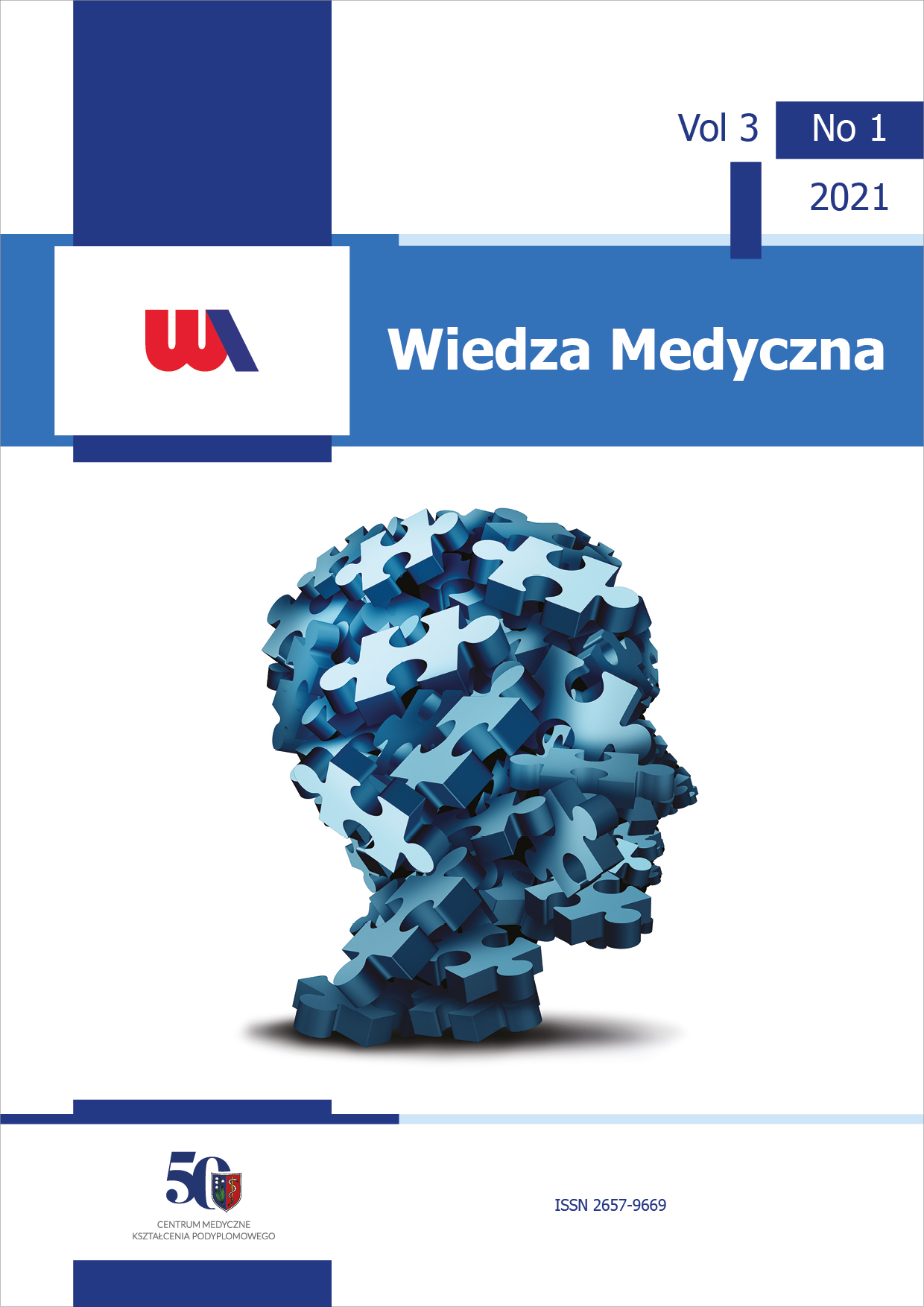Abstrakt
Metylofenidat (MFD) jest powszechnie stosowany w leczeniu zespołu nadpobudliwości psychoruchowej z deficytem uwagi (ADHD). Pomimo bycia stosowanym poza wskazaniami rejestracyjnymi, lek wchodzi w skład złożonych i wieloczynnikowych schematów leczenia narkolepsji i nadmiernej senności, razem z interwencjami behawioralnymi. Jest także czasem przepisywany poza zarejestrowanymi wskazaniami celem poprawy funkcjonowania intelektualnego, zmniejszenia uczucia zmęczenia czy poprawy koncentracji. Do częstych działań niepożądanych zalicza się m.in. bóle głowy, bezsenność, wzrost apetytu i nadciśnienie. Jednocześnie, lekarze muszą być świadomi stosunkowo rzadkich, ale potencjalnie groźnych działań niepożądanych jakimi są pobudzenie oraz objawy psychotyczne. Dotychczas opublikowano kilka opisów przypadków psychoz wyindukowanych stosowaniem MFD, jednak większość z nich dotyczy dzieci i nastolatków (1), a znacznie mniej wiadomo na temat psychoz wyindukowanych lekiem wśród dorosłych pacjentów (2). W poniższym artykule został przedstawiony opis przypadku 31 letniej, dotychczas nieleczonej lekami przeciwpsychotycznymi pacjentki, u której w wyniku stosowania MFD wystąpiły zaburzenia psychotyczne. Każdorazowo, przed włączeniem do leczenia MFD, zalecana jest uważna ocena zawierająca badanie kliniczne, wywiad medyczny oraz dotyczący obciążeń chorobami psychicznymi w rodzinie, a także występowania u pacjenta możliwych wczesnych objawów psychotycznych.
Bibliografia
(1) Hollis Ch, et al. Methylphenidate and the risk of psychosis in adolescents and young adults: a population-based cohort study. The lancet Psychiatry 2019; 6:651-658.
(2) Ghadrdan E, Mousavi M, Ghaeli P. Methylphenidate-Induced Psychotic Symptoms in 65-Year-Old Female with ADHD. Iran J Psychiatry 2018; 13(4):310-313.
(3) Faraone, Stephen V, et al. The worldwide prevalence of ADHD: is it an American condition? World psychiatry: official journal of the World Psychiatric Association 2003; 2(2):104-13.
(4) Faraone, Stephen V, Biederman J. What is the prevalence of adult ADHD? Results of a population screen of 966 adults. Journal of attention disorders 2005; 9(2):384-91.
(5) Polanczyk G, de Lima MS, Horta BL, Biederman J, Rohde LA. The worldwide prevalence of ADHD: A systematic review and metaregression analysis. Am J Psychiatry 2007; 164(6):942-948.
(6) Gaidamowicz R, et al. ADHD – the scourge of the 21st century? Psychiatr Pol 2018; 52(2):287-307.
(7) Huss, Michael, et al. Methylphenidate dose optimization for ADHD treatment: review of safety, efficacy, and clinical necessity. Neuropsychiatric disease and treatment 4 Jul 2017; 13:1741-1751.
(8) National Institute for Health and Care Excellence [NICE] guidelines for the treatment of adult ADHD. 2008. https://www.nice.org.uk/guidance/cg72 [retrieved on September 2020].
(9) https://www.fda.gov/media/88736/download.
(10) The guidelines of the European Medicines Agency define off-label use as medicinal product intentionally used for a medical purpose not in accordance with the authorised product information; Guideline on good pharmacovigilance practices (GVP). Module V– risk management systems. 2012.
(11) Rozans M, Dreisbach A, Lertora JJ, Kahn MJ. Palliative uses of methylphenidate in patients with cancer: a review. J Clin Oncol 2002; 20(1):335-9.
(12) Ruthirakuhan MT, Herrmann N, Abraham EH, Chan S, Lanctôt KL. Pharmacological interventions for apathy in Alzheimer's disease. The Cochrane Database of Systematic Reviews 4 May 2018; 5:CD012197.
(13) Verghese C, Abdijadid S. Methylphenidate. [updated 2020 May 7]. In: StatPearls [internet]. Treasure Island (FL): StatPearls Publishing 2020 Jan. https://www.ncbi.nlm.nih.gov/books/NBK482451/.
(14) Sabe M, Kirschner M, Kaiser S. Prodopaminergic Drugs for Treating the Negative Symptoms of Schizophrenia: Systematic Review and Meta-analysis of Randomized Controlled Trials. J Clin Psychopharmacol 2019 Nov/Dec; 39(6):658-664.
(15) Rohde C, Brink P, Østergaard SD, Nielsen J. The use of stimulants in depression: Results from a self-controlled register study. Aust N Z J Psychiatry 2020 Aug; 54(8):808-817.
(16) Dell'Osso B, Dobrea C, Cremaschi L, Arici C, Altamura AC. Wake-promoting pharmacotherapy for psychiatric disorders. Curr Psychiatry Rep December 2014; 16(12):524.
(17) Kraus MF, Burch EA. Methylphenidate hydrochloride as an antidepressant: controversy, case studies, and review. South Med J 1992; 85(10):985-91.
(18) Findling RL, Dogin JW. Psychopharmacology of ADHD: children and adolescents. J Clin Psychiatry 1998; 59(Suppl 7):42-49.
(19) Wender PH. Pharmacotherapy of attention-deficit/hyperactivity disorder in adults. J Clin Psychiatry 1998; 59(Suppl 7):76-79.
(20) https://www.ema.europa.eu/en/medicines/human/referrals/methylphenidate.
(21) Capp PK, Pearl PL, Conlon C. Methylphenidate HCl: therapy for attention deficit hyperactivity disorder. Expert Rev Neurother 2005 May; 5(3):325-31.
(22) Markowitz JS, DeVane CL, Ramamoorthy S, Zhu HJ. The psychostimulant d-threo-(R,R)-methylphenidate binds as an agonist to the 5HT(1A) receptor. Pharmazie 2009 Feb; 64(2):123-5.
(23) Morton WA, Stockton GG. Methylphenidate Abuse and Psychiatric Side Effects. Prim Care Companion J Clin Psychiatry 2000; 2:159-164.
(24) Levine B, Caplan YH, Kauffman G. Fatality resulting from methylphenidate overdose. J Anal Toxicol 1986; 10: 209-210.
(25) Moran L, Ongur D, Hsu J, Castro V, Perlis R, Schneeweiss S. Psychosis with Methylphenidate or Amphetamine in Patients with ADHD. New England Journal of Medicine 2019; 380(12): 1128-1138. DOI:10.1056/NEJMoa1813751.
(26) Ross RG. Psychotic and manic-like symptoms during stimulant treatment of attention deficit hyperactivity dis-order. Am J Psychiatry 2006; 163(7):1149-1152.
(27) Hollis, Chris et al. op. cit.
(28) Castagnini A, Bertelsen A, Berrios GE. Incidence and diagnostic stability of ICD-10 acute and transient psychotic disorders. Compr Psychiatry 2008; 49(3):255-261.
(29) Salvatore P, Baldessarini RJ, Tohen M, et al. McLean-Harvard International First-Episode Project: two-year stability of ICD-10 diagnoses in 500 first-episode psychotic disorder patients. J Clin Psychiatry 2011; 72(2):183.
(30) Castagnini A, Foldager L, Bertelsen A. Long-term stability of acute and transient psychotic disorders. Australian & New Zealand Journal of Psychiatry 2013; 47(1):59-64.

Utwór dostępny jest na licencji Creative Commons Uznanie autorstwa 4.0 Międzynarodowe.

